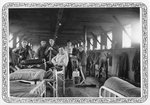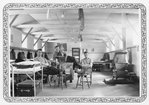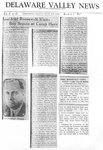 Narrowsburg
NarrowsburgLight Rain Fog/Mist, 43°
Wind: 8.1 mph
 Narrowsburg
NarrowsburgThere is a very good chance that, if you live in the Upper Delaware River region, you have conservation in your bones. We love the seasonal changes, the outdoors and the open spaces, and we realize …
Stay informed about your community and support local independent journalism.
Subscribe to The River Reporter today. click here
This item is available in full to subscribers.
Please log in to continue |








There is a very good chance that, if you live in the Upper Delaware River region, you have conservation in your bones. We love the seasonal changes, the outdoors and the open spaces, and we realize what a treasure Mother Nature has given us.
But conservation was not always an important consideration in Sullivan and other nearby counties. In reality, many of the conservation practices of today were born out of years of misuse and abuse of our land and forests. The old-growth forest, home of the Leni-Lenape native people, was cut down long ago, falling to two of the nation’s and our region’s earliest industries—timber and tanning. (Later, tourism would round out the picture of our local economic history—the three T’s.)
Timber and tanning
As settlers arrived in the Delaware River Valley, local forests were harvested to feed Philadelphia’s shipbuilding industry. Later, during the Civil War, Sullivan County and its neighbors were home to tanning operations that made most of the belts, holsters, saddles and boots of the time. Hemlock trees provided tannins for the tanning process, and hickory trees provided the “ideal” color for making leather. The forests became depleted, leaving soil vulnerable to erosion and unable to rejuvenate itself. Conservation as we know it today was unknown.
Then, things began to change. In our own area, one of America’s first conservationists, Gifford Pinchot (1865-1946), whose home is the present-day historical site Grey Towers in Milford, PA, was chosen the first chief of the U.S. Forestry Service. He put conservation of forests high on the nation’s priority list. (Pinchot is credited with coining the term “conservation ethic.”)
The Civilian Conservation Corps
This summer, the fascinating story of how parts of our area came to be reforested will be told in a celebration just outside of Narrowsburg, NY. The event marks the 80th year since the inception of the Civilian Conservation Corps (CCC), a plan born in the 1930s to give men jobs during the Great Depression and to rebuild a conservation ethic in our nation.
On August 4, 2013, a full day of events is scheduled on the site of Sullivan County’s historic CCC Camp at Ten Mile River (TMR) Boy Scout Camp. There will be activities for the whole family, including tours of the CCC Camp; discussions with CCC expert John Dowd; interviews with a re-enactor portraying Franklin Delano Roosevelt (FDR), the charismatic U.S. president who launched the CCC; plus displays of memorabilia, artifacts and more. The story of the CCC is a tale of noble ideas, desperate times and the men who had nothing to lose and everything to gain.
The Great Depression
Following the Stock Market Crash of 1929, America was thrown into the grip of the Great Depression. Unemployment was (under)estimated at 25%. Families became splintered as men left home to travel great distances in search of work. Conditions were made worse by the Dust Bowl, caused largely by a crippling drought (1934-1937) in the Great Plains, but exacerbated by years of misuse of our nation’s agricultural lands.
In 1933, as FDR was pushing through his “New Deal” relief programs, the CCC was born. Sometimes called Roosevelt’s “Tree Army,” it saw the fastest mobilization of young men in the U.S. in peace time. Its purpose was two-fold—first, to provide unskilled manual labor jobs to a nation of young men struggling to find work; and secondly, to establish a natural resources conservation program in every state and territory.
Enrollees were provided housing, clothing, food and medical care and were paid $30 a month. Of this, $25 had to be sent home. After a seven-hour workday, classes were offered in reading, writing and other skills, such as woodworking, metal work, typing and photography, to prepare the men for life after the CCC.
During its nine years of operation, FDR’s “Tree Army” of 2.5 million men would be responsible for planting three billion trees to help reforest America. The CCC can be credited with establishing many of our national parks; and the Appalachian Trail, which runs from Maine to Georgia, owes much of its clearing to the CCC.
Ten Mile River Scout Camp
The history of the Ten Mile River CCC Camp and the TMR Scout Camp are intertwined. In the 1920s, when FDR was governor of New York and had been involved for years with Scouting, he was part of a group of Scout officials charged with finding a large parcel of land to be the home camp for the New York City (NYC) Scouts. After raising $1 million to purchase and develop 10,000 acres of woodlands in Sullivan County near Narrowsburg, the NYC Scouts took possession of their camp. The deed was recorded on October 7, 1927 in Monticello, NY.
Just six years later, in October 1933, CCC Camp 65 was established, operating for several years until the program was terminated. During that time, CCC enrollees helped establish roads, fire trails and communication lines from Scout camp to Scout camp.
The CCC’s 80th anniversary
The museum at TMR is the unifying element of the 80th anniversary event of the CCC. The large collection of memorabilia of both the CCC and TMR includes local coin collections, 2,000-year-old Indian arrowheads and other tools discovered in the rock quarries found on the camp property. There will be displays by local historical societies and the National Park Service. A comprehensive video collection includes the PBS documentary “The C.C.C.”
TMR/CCC day on August 4 is open to the public from 9 a.m. to 3 p.m. Admission and parking are free. According to event curator David Malatzky, this is a “must-see” for lovers of nature and local history and a great outdoor experience for the whole family.
Comments
No comments on this item Please log in to comment by clicking here